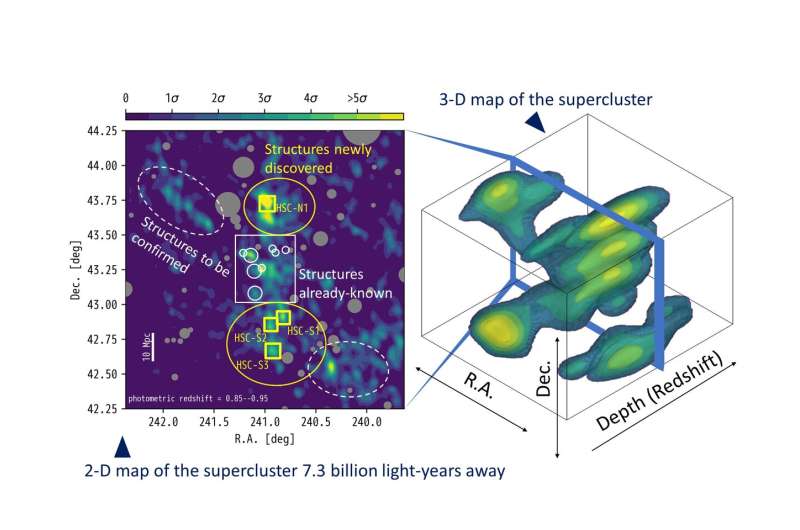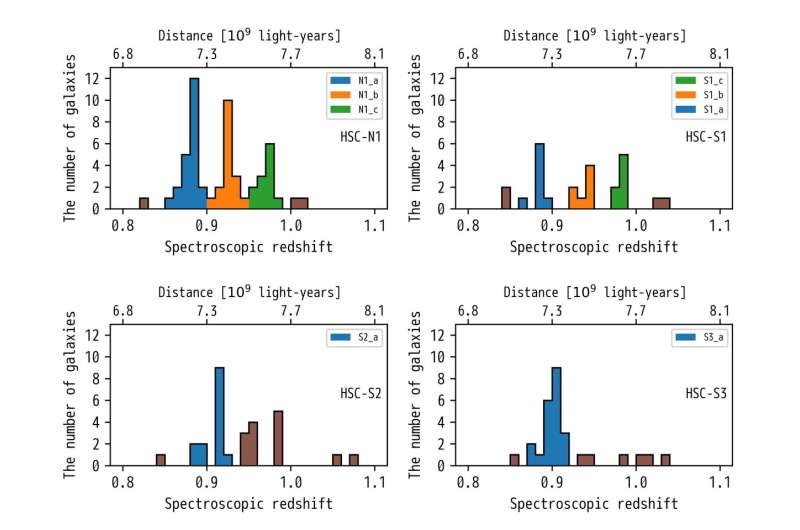The whole picture of a distant supercluster in three dimensions

Using the Subaru Telescope and Gemini-North Telescope, a team of astronomers has revealed that the supercluster CL1604, a distant supercluster located about 7.3 billion light-years away, is a large-scale 3-D structure extending over about 160 million light-years in the north-south direction. This is more than two times more extended than previously known. Until now, astronomers saw merely the "tip of the iceberg" of this supercluster. The wide-field capability of the Subaru Telescope enabled the team to survey the whole of the supercluster and the Gemini-North Telescope played a critical role in confirming the structures. This is the outcome of the synergy of the telescopes of the Maunakea observatories.
Galaxies are distributed inhomogeneously in the universe. It is well-known that nearby galaxies are strongly influenced by their environment, e.g., whether they are located in dense areas called galaxy clusters, or less dense areas called voids. However, how galaxies form and evolve along with the growth of the cosmic web structures is one of the hot topics of astronomy. A wide-field survey of the distant universe allows astronomers to witness what actually happened with galaxies in the early phase of structure formation in the universe. Among the few superclusters currently known, one of the best targets for study is the supercluster CL1604. Based on previous studies, its extent is 80 million light-years and its era is 7.3 billion years ago.
The uniqueness of the data taken by Hyper Suprime-Cam (HSC) on the Subaru Telescope is the deep imaging data over a field wide enough to cover the known supercluster and the surrounding area fully. A team led by Masao Hayashi and Yusei Koyama from NAOJ estimated the distances of individual galaxies from the galaxy colors using a technique called "photometric redshift." Then the three-dimensional picture of the large-scale structures appeared, consisting of several galaxy clusters newly discovered in the north-south direction, as well as the structures already known (Figure 1).

Furthermore, the team used the Faint Object Camera and Spectrograph (FOCAS) on the Subaru Telescope and the Gemini Multi-Object Spectrograph (GMOS) on Gemini-North to confirm the precise distances of 137 galaxies associated with the galaxy clusters revealed by HSC (Figure 2). They found that the supercluster is a complex, large-scale structure over the vast projected area and also along the line-of-sight direction in 3-D. The galaxies spread over the 160 million light-years seem to be independent due to the vast area, however, the spectroscopic observations have revealed that the galaxies formed simultaneously and then evolved along with the growth of large-scale structures.
The Milky Way galaxy is a member of the Local Group on the outskirts of the Virgo galaxy cluster. A team led by an astronomer from the University of Hawaii recently revealed that the Virgo Cluster is a member of a more extended, enormous structure called the Laniakea Supercluster. "The supercluster we discovered 7.3 billion years ago may grow to be a huge large-scale structure similar to Laniakea where we live," said Hayashi.
These results were published in Publications of the Astronomical Society of Japan.
More information: Masao Hayashi et al. The whole picture of the large-scale structure of the CL1604 supercluster at z∼0.9, Publications of the Astronomical Society of Japan (2019). DOI: 10.1093/pasj/psz097
Provided by Subaru Telescope





















